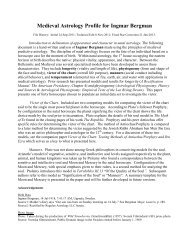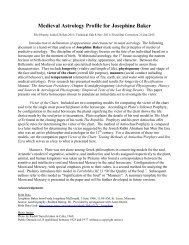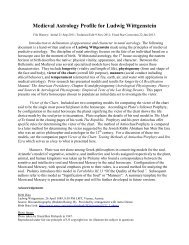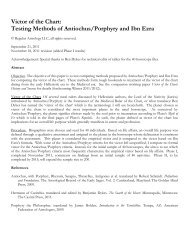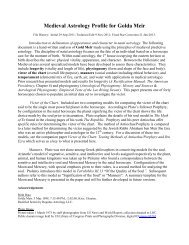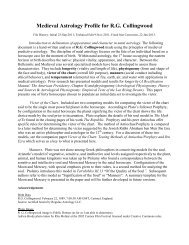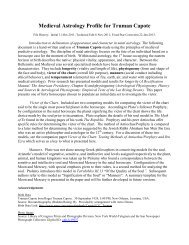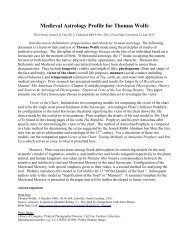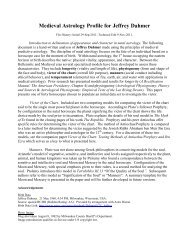Working Paper on Astrological Physiognomy: History and Sources
Working Paper on Astrological Physiognomy: History and Sources
Working Paper on Astrological Physiognomy: History and Sources
You also want an ePaper? Increase the reach of your titles
YUMPU automatically turns print PDFs into web optimized ePapers that Google loves.
<str<strong>on</strong>g>Working</str<strong>on</strong>g> <str<strong>on</strong>g>Paper</str<strong>on</strong>g> <strong>on</strong> <strong>Astrological</strong> <strong>Physiognomy</strong>: <strong>History</strong> <strong>and</strong> <strong>Sources</strong><br />
bodily decay observed from mid-life to death. As final refinements to the planet’s synodic cycle<br />
with the Sun, Ptolemy states that planets at their first stati<strong>on</strong> make the body powerful <strong>and</strong><br />
muscular, retrograde planets interfere with proper proporti<strong>on</strong>, <strong>and</strong> planets at their sec<strong>on</strong>d stati<strong>on</strong><br />
yield weak bodies. 31<br />
In additi<strong>on</strong> to Ptolemy’s refinements for height <strong>and</strong> weight, other authors suggest<br />
c<strong>on</strong>sidering whether the Ascendant falls in a sign of l<strong>on</strong>g or short ascensi<strong>on</strong>, with a<br />
corresp<strong>on</strong>ding effect <strong>on</strong> tall bodies (l<strong>on</strong>g ascensi<strong>on</strong>) <strong>and</strong> short bodies (short ascensi<strong>on</strong>).<br />
Alternatively, some authors c<strong>on</strong>sider whether a planetary significator is placed in early or late<br />
degrees of a zodiac sign as an influence <strong>on</strong> tallness (late degrees) <strong>and</strong> shortness (early degrees). 32<br />
Individual Degrees. As a final refinement, authors including Abu Ma’shar, al-Qabisi, <strong>and</strong><br />
B<strong>on</strong>atti classify individual degrees as masculine, feminine, bright, dark, smoky, <strong>and</strong> empty. 33<br />
Whether of not these degrees are fixed in the tropical zodiac or refer to some implicit effect of<br />
fixed stars (which would require precessi<strong>on</strong> to adjust the degree definiti<strong>on</strong>s) remains unknown.<br />
III. Introducti<strong>on</strong> to <strong>Sources</strong> <strong>on</strong> <strong>Physiognomy</strong><br />
Much like humoural <strong>and</strong> temperament theory, physiognomy was a science first developed<br />
by a group of philosopher-physicians with an interest in the diagnosis <strong>and</strong> treatment of disease.<br />
Astrologers subsequently adapted physiognomy rules to planets <strong>and</strong> zodiac signs just as<br />
philosopher-physicians developed their models based <strong>on</strong> analogies within the physical<br />
envir<strong>on</strong>ment. Because of this two-track developmental process, physiognomy has at times<br />
veered more towards a purely empirical approach rooted in medical observati<strong>on</strong>s; at other times<br />
towards the divinatory approach of astrology. 34 For this reas<strong>on</strong> a literature review for<br />
physiognomy requires access to both n<strong>on</strong>-astrological <strong>and</strong> astrological sources. At times the<br />
divisi<strong>on</strong> is not clear cut; nevertheless, most authors can typically be described as either a<br />
philosopher-physician or an astrologer.<br />
<strong>Sources</strong> <strong>on</strong> n<strong>on</strong>-astrological physiognomy are vast. If Swain et. al., (2007) <strong>and</strong> Porter<br />
(2005) are indicative, then the sum of primary <strong>and</strong> sec<strong>on</strong>dary sources exceed several hundred.<br />
The fact that I can claim to narrow sources <strong>on</strong> n<strong>on</strong>-astrological physiognomy to a few pages rests<br />
<strong>on</strong> academic research through the early modern period which has identified specific texts as<br />
can<strong>on</strong>ical. <strong>Sources</strong> listed after Lavater are my own selecti<strong>on</strong>s.<br />
31 Claudius Ptolemy, Tetrabiblos, Book III, Chapter 11.<br />
32 For examples of these rules, see references for M<strong>on</strong>tulmo <strong>and</strong> Schoener in the compani<strong>on</strong> <str<strong>on</strong>g>Working</str<strong>on</strong>g> <str<strong>on</strong>g>Paper</str<strong>on</strong>g> <strong>on</strong><br />
<strong>Astrological</strong> <strong>Physiognomy</strong>: <strong>History</strong> <strong>and</strong> <strong>Sources</strong>.<br />
33 Guido B<strong>on</strong>atti, Book of Astr<strong>on</strong>omy, trans. Ben Dykes, Treatise 2, Chapters 23-24, pp. 85-87.<br />
34 Ant<strong>on</strong>ella Ghersetti, “<strong>Physiognomy</strong> <strong>and</strong> Medicine in Islamic Culture,” in Sim<strong>on</strong> Swain, ed. Seeing the Face,<br />
Seeing the Soul: Polem<strong>on</strong>’s <strong>Physiognomy</strong> from Classical Antiquity to Medieval Islam. Oxford University Press,<br />
2007, p. 306<br />
©Regulus Astrology LLC, 2010. All Rights Reserved.<br />
19




